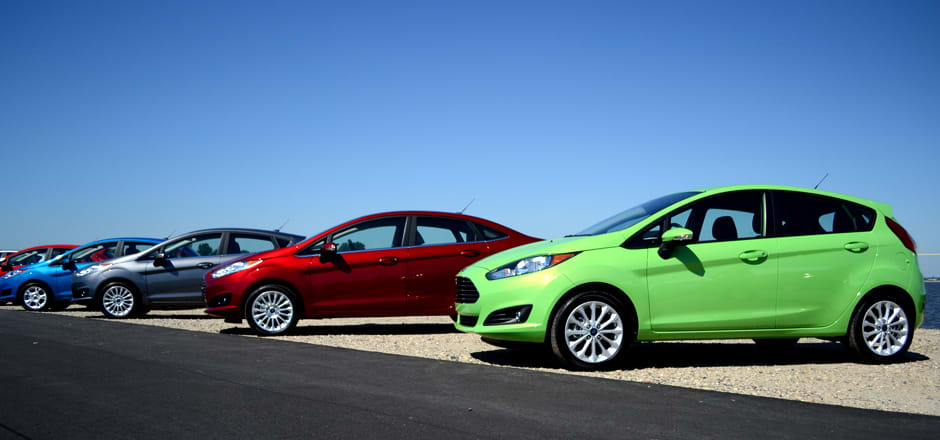Introduction
First off, the smallest Ford finally gets a full-featured infotainment system with navigation as an option. That's a deal-clincher when it comes to the Fiesta's target market of young folks, first-time buyers, and city dwellers. Luckily, the Fiesta's got the latest iteration of MyFord Touch, which seems to have ironed out a lot of the kinks found in prior versions.
Finally, Ford's fixed all the glitches with the PowerShift transmission, which makes the Fiesta remarkably sprightly around town. With a base price below $15,000 including destination charges, and a fully-loaded Titanium model selling for under $22,000, we'd definitely recommend a test drive if you're in the market for a new, entry-level car.
Tech & Entertainment
The 2014 Fiesta marks a few notable tech debuts, which is remarkable considering the car's low price. The new model is the first Fiesta to feature the MyFord Touch infotainment system, optional on the SE trim and standard on the Titanium. There's a unique 6.5-inch screen instead of the 8-inch version found on larger Fords.
Most importantly, however, the new Fiesta is the first Ford to feature an updated version of the oft-maligned MyFord Touch infotainment system. We spent about four hours using the touchscreen-based system to play music and navigate unfamiliar roads, and can confidently say it's come quite close to its full potential. Initially, it seemed more responsive and less error-prone than its predecessor. In fact, it didn't crash or hang a single time during our trip. That's more than can be said for the 2012 Flex we drove a few months back.
{{photo_gallery "tech"}}
The new system's home screen still divides the touchscreen into a four-quadrant summary of infotainment functions, but a new user interface makes it easier to expand those quadrants to full-screen for accessing menus. Ford engineers also made the smart decision to move frequently-used functions like volume, tuning, and climate to physical buttons and knobs on the center stack. Now, a "Settings" feature lives where the climate quadrant once was.
That's not to say we had no complaints. In Birds-Eye mode, the Navigation system occasionally seemed to lack the processing power to keep up with the car's position in tough maneuvers like traffic circles and merges. And getting back to the home screen required a press of a tiny touchscreen button. We're of the mindset that "back" and "home" functions should be on physical buttons, as they're usually pressed when the driver has already spent some time glancing at the infotainment screen.
Design
{{photo_gallery "exterior"}}
The majority of changes to the new car took place right up front. Now, the Fiesta shares the chromed, trapezoidal grill that distinguishes the Taurus, Fusion, and Focus. The hood is new, too. The Fiesta is still available in both sedan and hatchback versions, and if you step up to the Titanium package, you'll get some neat chrome accents that enhance the car's lines without getting too rococo.
{{photo_gallery "interior"}}
Inside, the 6.5-inch MyFord Touch screen dominates the dash. Perched above physical buttons for climate control, the hooded screen kind of makes the whole center stack combo look like a Moai statue. The dash, door inserts, upholstery, center console, and center stack are all finished in a wide variety of materials, none of which feels particularly cheap. In fact, as long as you aren't in the cramped backseat, nothing about the Fiesta really trumpets its low price. It seems to do a better job than most subcompacts at feeling larger than it actually is. That's especially apparent in the sedan's deep trunk.
Driving Experience
Mechanically, the 2014 Fiesta is nearly identical to its predecessors, with one important exception: The PowerShift dual-clutch transmission has been vastly improved.
First, some quick background: Unlike a traditional automatic, whose design differs quite a bit from a manual transmission, Ford's PowerShift dual-clutch transmission is basically a manual transmission that can make its own gearshifts. In theory, that makes for faster shifts and better fuel economy—the benefits of a manual with the ease of an automatic.
Unfortunately, when it debuted in 2011, the original PowerShift rowed through the gears like a high school kid in driver's ed, rolling back at stoplights and lurching around parking lots. Thankfully, Ford's engineers have taken feedback to heart and completely reprogrammed the PowerShift for 2014, adding a hill-start assist and improving the "shuffle" between gears at low speeds. The difference was immediately apparent. The folks in Dearborn can now check "Fix PowerShift" off their to-do list.
Powertrain-wise, the two most important additions to the Fiesta lineup are coming later in the year. First, there's the ST variant, a hot hatch with a 197-hp engine and sport-tuned suspension, priced under $22,000 and aimed at enthusiasts. At the complete other end of the spectrum, more frugal customers will also be able to choose a fuel-sipping 1.0L three-cylinder engine. Pricing hasn't been announced on that one, but we were told it would likely be bundled with some options and slot above the entry-level S model. We'll keep you updated when both of those hit the market.
Conclusion
The O'Jays once said that you've got to give the people what they want, and that's a lesson that Ford's taken to heart with the 2014 Fiesta. By addressing nearly everything wrong with the outgoing model, they've given us an affordable and attractive subcompact. If that's what you want, the Fiesta is a car to watch.
Trim Levels
Currently, you'll be able to get the Fiesta sedan and hatchback in one of three trim levels. The S is the base, starting at just $14,795 with destination charge for the sedan. At that price, you get no optional equipment, manual windows, and a manual transmission, but you do still get Sync and Bluetooth.
Step up to the SE and you'll get some funkier cloth or leather upholstery options, plus the ability to add MyFord Touch and automatic climate control. The Titanium bundles all the premium features, and the only major options are navigation and a moonroof. The fully-loaded Titanium hatch we drove stickered at $21,280—not bad at all.
The three-cylinder 1.0L and the sporty ST will come later this year, with official pricing to be announced soon.
Powertrain
The S, SE and Titanium Fiestas all come with a 1.6L four-cylinder engine that makes 120 hp and 112 lb-ft of torque. A five-speed manual is standard across the lineup, but a PowerShift dual-clutch automatic is optional.
Safety
The IIHS rates the Fiesta a Top Safety Pick, with an overall "Good" rating—the highest that agency gives. All individual ratings are Good, with the exception of the driver side impact ratings for torso and pelvis, which are Acceptable.
NHTSA gives the Fiesta four out of five stars, with four stars for a frontal crash, five for a side crash, and four for rollover risk.
Fuel Economy
With a manual transmission, the Fiesta is rated 39 hwy/29 city/32 combined. An automatic bumps that up to 38 hwy/27 city/31 combined. With a lead foot around town, we got 26 mpg in a similar car.
Equipped with the Super Fuel Economy package, only available on an SE with an automatic, the Fiesta boasts 41 hwy/30 city/34 combined. The ST gets 35 hwy/26 city/29 combined.
Meet the tester
Keith was the Editor in Chief of Reviewed's appliance and automotive sites. His work has appeared in publications such as Wired, Car & Driver, and CityLab.
Checking our work.
Our team is here for one purpose: to help you buy the best stuff and love what you own. Our writers, editors, and lab technicians obsess over the products we cover to make sure you're confident and satisfied. Have a different opinion about something we recommend? Email us and we'll compare notes.
Shoot us an email


